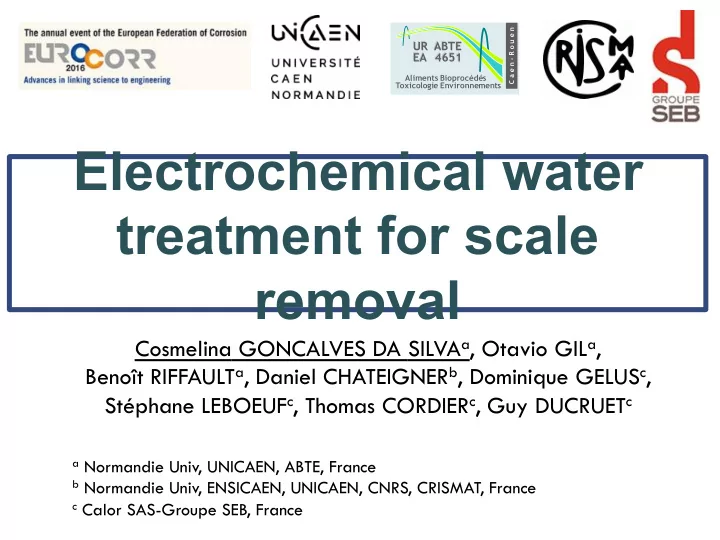

C a e n - R o u e n UR ABTE UR ABTE EA 4651 EA 4651 Aliments Bioprocédés Toxicologie Environnements Electrochemical water treatment for scale removal Cosmelina GONCALVES DA SILVA a , Otavio GIL a , Benoît RIFFAULT a , Daniel CHATEIGNER b , Dominique GELUS c , Stéphane LEBOEUF c , Thomas CORDIER c , Guy DUCRUET c a Normandie Univ, UNICAEN, ABTE, France b Normandie Univ, ENSICAEN, UNICAEN, CNRS, CRISMAT, France c Calor SAS-Groupe SEB, France
C ONTEX T Hard water Scale deposits Mg(OH) 2 CaCO 3 2
C ONTEX T Hard water map o f Hardness French Rating Counties Soft < 15 26 % Moderately 15 - 30 31 % Hard 74 % Hard 30 - 40 34 % 43 % Very Hard > 40 9 % Note: 1 o f = 10 mg L -1 CaCO 3 Source: Own work , from Skippy le Grand 3 Gourou, [CCO] via Wikimedia Comm.
C ONTEX T Scale deposits damages… F Biological: F Material: 4
C ONTEX T Solutions… w Chemicals/inhibitors Application: water softening w Membrane systems w Degassing w Electrochemical electrolysis - R. Ketrane, B. Saidani, O. Gil, L. Leleyter, F. Baraud, Desalination, 249 (2009) 1397. - I. Zaslavschi, H. Shemer, D. Hasson, R. Semiat, J. Membrane Sci., 445 (2013) 88. 5 - D. Hasson, V. Lumelsky, G. Greenberg, Y. Pinhas, R. Semiat, Desalination, 230 (2008) 329.
C ONTEX T Solutions… w Electrochemical water electrolysis At the anode: Cathode Anode H 2 O (l) g 2H + + ½ O 2(g) ↑ + 2e - At the cathode: 2H 2 O (l) + 2e - g H 2(g) ↑ + 2OH - (aq) 6
C ONTEX T Solutions… w Electrochemical precipitation Displacement of calco-carbonic equilibrium: (aq) g CO 3 - (aq) + OH - 2- HCO 3 (aq) + H 2 O (l) Calcium carbonate precipitation: (aq) g CaCO 3(s) i Ca 2+ (aq) + CO 3 2- CaCO 3 precipitation = OH - consumption è H + excess ( ò pH) 7
C ONTEX T w Electrochemical precipitation - ERCA 2 electrolyser (by Lyonnaise des Eaux) Moderate softening 33% of treatment Application: water distribution 8
C ONTEX T w Electrochemical precipitation - Present work: High softening ≈ 90% of treatment Application: small heating devices 9
E XPERIMENT AL w Total current intensity Set up w Water flow rate Level detector Power source Caen tap water (40 o f ) Anode Non treated water supplier Cathode Filter Pump# 2 Cell Pump# 1 - Hardness degree: MColortest ™ , Merck Treated water - pH: CyberScan pH 510, - G. Dominique, Patent No. FR3005665(A1) , Nov. 21, 2014. Eutech Instruments 10 - G. Dominique, Patent No. EP2803761(A1) , Nov. 19, 2014.
R ESULT S Hardness and pH evolution with treatment time Current intensity = 0.5 A Flow rate = 30 mL min -1 Results comparing After 20 min è ò Hardness and pH 11
� Effect of the total current intensity Flow rate = 30 mL min -1 After 60 min of treatment 90% of treatment ñ Current è ò Hardness and pH 12
� Effect of the flow rate Current intensity = 0.5 A After 60 min of treatment 97% of treatment ñ Flow rate è ñ Hardness and pH 13
� Theoretical pH calculation To treat 90% of the water scale è 90% of [Ca 2+ ]: pH = - log(1.8 [Ca 2+ ] - [HCO 3 - ]) Considering that: - ] = 349 mg L − 1 = 5.7 10 -3 mol L − 1 (determined by titration) [HCO 3 [Ca 2+ ] = 169.33 mg L − 1 = 4.2 10 -3 mol L − 1 (determined by ICP-AES) Theoretical pH = 2.7 Experimental pH values (2.6 - 3.3) ≈ Theoretical pH (2.7) ä - and Ca 2+ ions initial concentrations ratio HCO 3 14
� SEM imaging and XRD analysis Current intensity = 0.5 A Flow rate = 30 mL min -1 100% Calcite or CaCO 3 Calcite + Aragonite 15 - S. Ouhenia, D. Chateigner, M.A. Belkhir, E. Guilmeau, C. Krauss, J. Cryst. Growth, 310 (2008) 2832.
C ONCLUSI ONS w The system allows us to choose the final hardness setting the total current intensity or water flow rate; w A high water softening can be obtained; w The final pH depends on the bicarbonate and calcium ions initial concentrations ratio; w Depending on the final hardness/pH desired, different applications can be conceived. 16
Thank you for your attention! 17
Recommend
More recommend